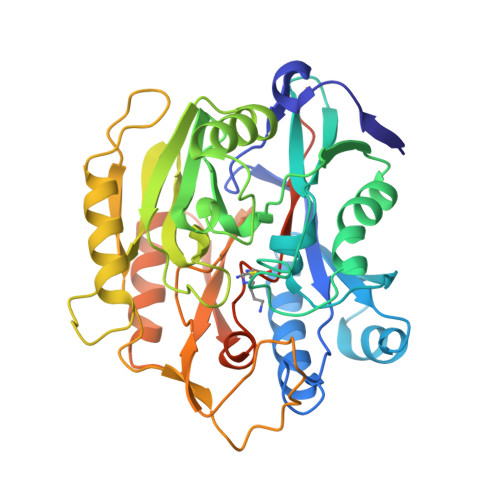The Gene Cluster for Agmatine Catabolism of Enterococcus Faecalis: Study of Recombinant Putrescine Transcarbamylase and Agmatine Deiminase and a Snapshot of Agmatine Deiminase Catalyzing its Reaction.
Llacer, J.L., Polo, L.M., Tavarez, S., Alarcon, B., Hilario, R., Rubio, V.(2007) J Bacteriol 189: 1254
- PubMed: 17028272
- DOI: https://doi.org/10.1128/JB.01216-06
- Primary Citation of Related Structures:
2JER - PubMed Abstract:
Enterococcus faecalis makes ATP from agmatine in three steps catalyzed by agmatine deiminase (AgDI), putrescine transcarbamylase (PTC), and carbamate kinase (CK). An antiporter exchanges putrescine for agmatine. We have cloned the E. faecalis ef0732 and ef0734 genes of the reported gene cluster for agmatine catabolism, overexpressed them in Escherichia coli, purified the products, characterized them functionally as PTC and AgDI, and crystallized and X-ray diffracted them. The 1.65-Angstroms-resolution structure of AgDI forming a covalent adduct with an agmatine-derived amidine reactional intermediate is described. We provide definitive identification of the gene cluster for agmatine catabolism and confirm that ornithine is a genuine but poor PTC substrate, suggesting that PTC (found here to be trimeric) evolved from ornithine transcarbamylase. N-(Phosphonoacetyl)-putrescine was prepared and shown to strongly (K(i) = 10 nM) and selectively inhibit PTC and to improve PTC crystallization. We find that E. faecalis AgDI, which is committed to ATP generation, closely resembles the AgDIs involved in making polyamines, suggesting the recruitment of a polyamine-synthesizing AgDI into the AgDI pathway. The arginine deiminase (ADI) pathway of arginine catabolism probably supplied the genes for PTC and CK but not those for the agmatine/putrescine antiporter, and thus the AgDI and ADI pathways are not related by a single "en bloc" duplication event. The AgDI crystal structure reveals a tetramer with a five-blade propeller subunit fold, proves that AgDI closely resembles ADI despite a lack of sequence identity, and explains substrate affinity, selectivity, and Cys357-mediated-covalent catalysis. A three-tongued agmatine-triggered gating opens or blocks access to the active center.
Organizational Affiliation:
Instituto de Biomedicina de Valencia (IBV-CSIC), C/Jaime Roig 11, 46010 Valencia, Spain.















